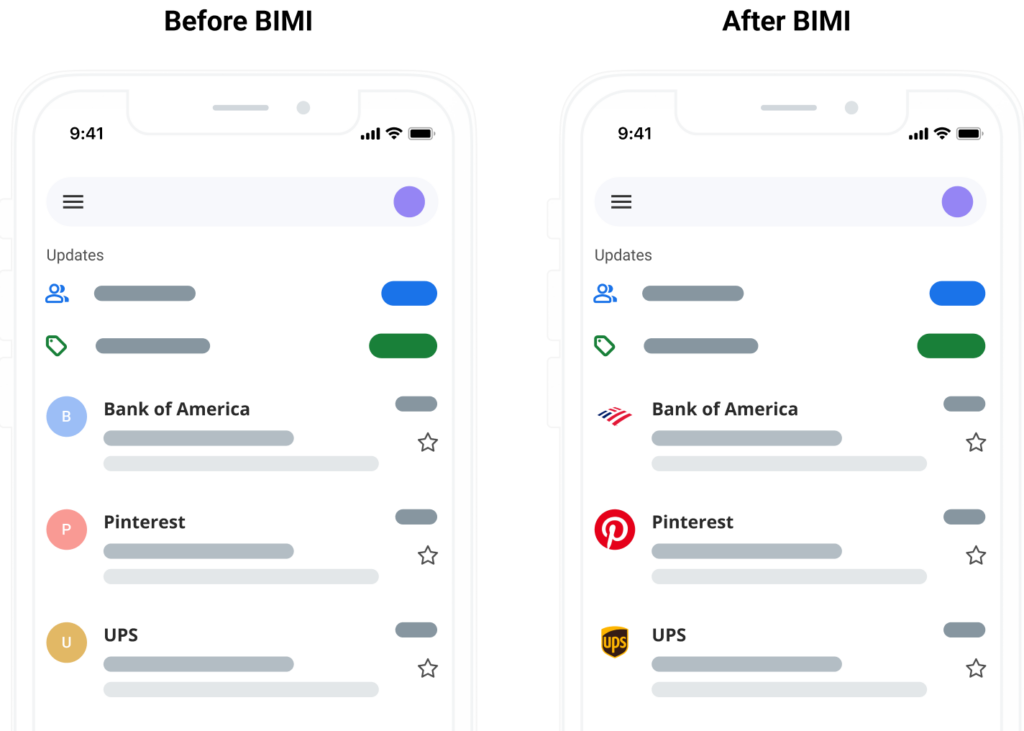Email Marketing
How to Create a BIMI Logo: Your Step-by-Step Guide

Email Marketing

Here’s a situation that could happen to email marketers like you in the near future.
You get a message from someone in the company who notices that one of your top competitors has a logo next to messages in the inbox. They demand to know, “Why doesn’t our brand’s logo show up in emails like that?”
What they’re likely seeing is the result of BIMI (Brand Indicators for Message Identification). A BIMI logo may appear when you’re implementing certain email authentication protocols that validate your domain as the sender. Those protocols prevent a type of phishing known as email spoofing, and a BIMI logo is visual proof of authentication.
Unfortunately, getting an official logo to display next to your brand’s emails isn’t as easy as uploading a jpeg somewhere. There are some specific steps you’ll need to follow and hoops to jump through before your BIMI logo is ready. But there are good reasons for that.
BIMI is an emerging email specification that helps solve two main problems:
The truth is, brand logos in email marketing have been around for a while. However, email clients like Gmail, Outlook, and Yahoo Mail all had their own ways of finding logos to use. That led to mistakes such as an ugly-looking logo, the wrong logo, or even explicit content showing up as an icon in the inbox.
BIMI solves this problem by giving brands control over which logo mailbox providers use. A BIMI record is published on your sending domain’s DNS, which tells the receiving mail server where to find the right logo.

Another problem BIMI seeks to address is weak DMARC policies that do nothing to stop forged emails from reaching a recipient’s inbox.
DMARC stands for Domain-based Message Authentication, Reporting and Conformance. It is an email specification that sits on top of SPF (Sender Policy Framework) and DKIM (DomainKeys Identified Mail). DMARC checks for those two protocols and has a policy telling mailbox providers what to do with messages that fail authentication.
This is where the problem comes in. A DMARC policy is set to either “p=none”, “p=quarantine”, or “p=reject”.
None means your DMARC policy lets every unauthenticated message through to the inbox. It tells mailbox providers not to take any action against authentication failures. Quarantine and reject DMARC policies are stronger. They advise receiving mail servers to filter emails that fail SPF and DKIM into spam or block them from delivery.
Plenty of brands still aren’t using DMARC at all. Many that do use it have weak DMARC policies set to “p=none”. If we want to stop spam and phishing, that needs to change.
The opportunity to have a BIMI logo is a motivation for brands to pursue tougher email authentication practices. That’s because BIMI readiness requires a policy set to quarantine or reject.
If someone assigns you the job of implementing BIMI or creating a BIMI logo, there are several things you need to know before you get started. Be aware, this process can take a while, but every step is necessary if you want to get the most out of BIMI.
Mailbox providers want to make sure they’re only displaying brand logos from reputable senders and that the sending domain truly owns the logo. For that reason, BIMI logos need to be trademarked.
If you’re unsure whether your brand’s logo is already trademarked, try looking it up using a tool from the World Intellectual Property Organization (WIPO).
If you need to get a trademark for your logo, these are the government offices that make it happen:
A new requirement for getting a BIMI logo to display involves verifying your ownership of that trademarked logo.
Google made this a requirement when it announced its support for BIMI logos in Gmail. You almost certainly have a large number of Gmail addresses among your subscribers. So, you’ll want to get verified and purchase a VMC.
Even though providers like Yahoo Mail and AOL don’t require VMCs, they may use these certificates to determine if you are a reputable sender with a verified BIMI logo.
To date, there are two organizations authorized to provide VMCs: Entrust and DigiCert. Expect a VMC to cost between $900 and $1,000 for the first year. Once your BIMI logo is verified, you’ll receive a Privacy Enhanced Mail (PEM) file, which will be added to your DNS.
Now that you’ve dealt with the red tape, let’s get down to designing your BIMI logo! Obviously, you’re not creating a new logo from scratch. But there are some BIMI logo best practices that will ensure it looks good in the email experience.
Your BIMI logo should be:
A BIMI logo can not be animated or interactive.
Mailbox providers may display your BIMI logo in slightly different ways. Plus, other types of applications could also start using BIMI for official logos in the future. The image from BIMIGroup.org below shows how it may look.

You can see why you’ll want to make sure the logo isn’t getting cropped out. So, leave some space around the logo and background.
You’ll probably find most of your brand’s logos are saved as PNGs and JPEGs. But that won’t work for a BIMI logo. BIMI requires the use of Scalable Vector Graphics (SVGs). They are XML files with some benefits that made the format ideal for BIMI logos.
First, an SVG is a lightweight file that looks good no matter how small or large it is displayed (hence the “scalable”). That’s because it uses a fixed set of shapes rather than pixels. BIMI also calls for the use of SVG P/S Tiny 1.2. The BIMI Group chose this version because it is considered more secure.
You can include additional information in XML files that could be used for tracking purposes. To keep BIMI records from being used for potentially unwanted or invasive purposes, the SVG portable secure P/S Tiny 1.2 version is required.
You’ll need to use a vector image editing program like Adobe Illustrator to create an SVG file. BIMI Group also lists some SVG conversion tools to use. After exporting your SVG, you still may need to do some manual editing to XML attributes. That includes removing the “x=” and “y=” attributes.
For further details, check out the BIMI Group’s article on creating BIMI SVG logo files.
When you’re ready to publish your BIMI TXT record to the DNS, it will need to list the location of your SVG file. This is defined in the “l=” tag of the record.
You can upload your BIMI logo to any secure server (https:), which could be your content delivery network (CDN). Then, the BIMI record will point to that file location or URL.
A BIMI record looks something like this:
default._bimi TXT "v=BIMI1; l=https://cdn.mydomain.com/bimilogo.svg;"
Once the record is published, mailbox providers can find your BIMI logo and display it next to emails that pass authentication.
Don’t forget: You’ll need a DMARC policy set to “p=quarantine” or “p=reject” in order to get a BIMI logo to display!
You might be telling yourself, “This seems like a lot of work.”

No, you’re not wrong. But we think it’s worth the effort for a couple of reasons.
First — stronger email authentication benefits everyone. Implementing DMARC with strong enforcement policies helps mailbox providers understand which messages are valid and which are spam or deceptive scams. That means your customers and subscribers are protected. Email authentication also protects your brand’s reputation and supports a good domain and sender reputation.
Second — There is some very interesting research indicating that a branded inbox experience is more effective and engaging.
Red Sift and Entrust partnered on a 2021 survey to find out what email recipients think about seeing logos in the inbox. Key findings suggest that BIMI logos could:
To find out more, check out the full study, Consumer Interaction with Visual Brands in Email. You can also see which brands are implementing BIMI when you visit BIMIRadar.com.
These results indicate that early adopters of BIMI could have an edge over the competition.
So, why wait for your CMO or the VP of Marketing to ask you about a BIMI logo? Get the process started yourself!